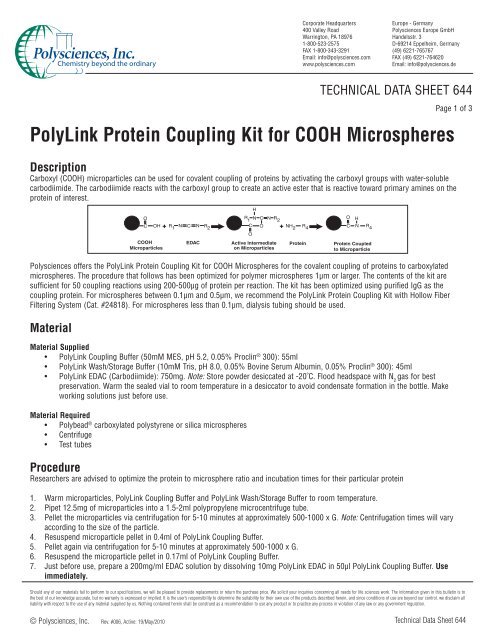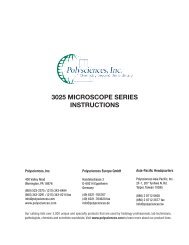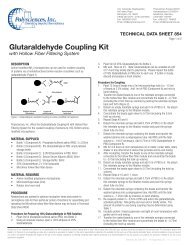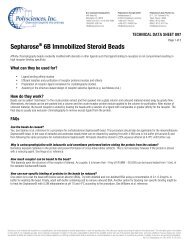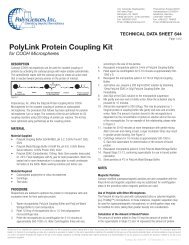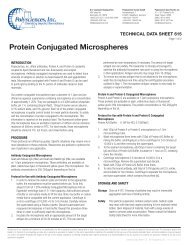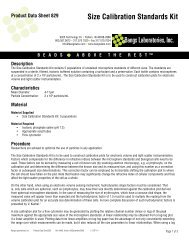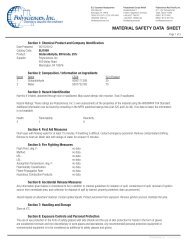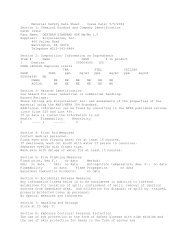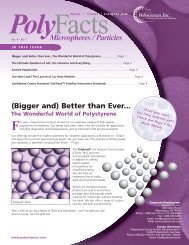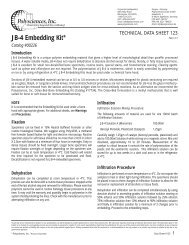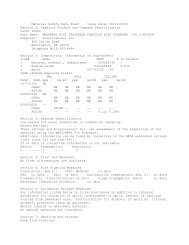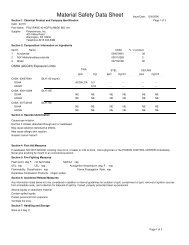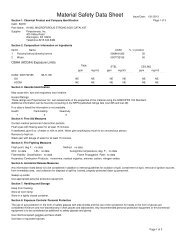PolyLink Protein Coupling Kit for COOH ... - Polysciences, Inc.
PolyLink Protein Coupling Kit for COOH ... - Polysciences, Inc.
PolyLink Protein Coupling Kit for COOH ... - Polysciences, Inc.
Create successful ePaper yourself
Turn your PDF publications into a flip-book with our unique Google optimized e-Paper software.
Corporate Headquarters<br />
400 Valley Road<br />
Warrington, PA 18976<br />
1-800-523-2575<br />
FAX 1-800-343-3291<br />
Email: info@polysciences.com<br />
www.polysciences.com<br />
Europe - Germany<br />
<strong>Polysciences</strong> Europe GmbH<br />
Handelsstr. 3<br />
D-69214 Eppelheim, Germany<br />
(49) 6221-765767<br />
FAX (49) 6221-764620<br />
Email: info@polysciences.de<br />
Technical Data Sheet 644<br />
<strong>PolyLink</strong> <strong>Protein</strong> <strong>Coupling</strong> <strong>Kit</strong> <strong>for</strong> <strong>COOH</strong> Microspheres<br />
Page 1 of 3<br />
Description<br />
Carboxyl (<strong>COOH</strong>) microparticles can be used <strong>for</strong> covalent coupling of proteins by activating the carboxyl groups with water-soluble<br />
carbodiimide. The carbodiimide reacts with the carboxyl group to create an active ester that is reactive toward primary amines on the<br />
protein of interest.<br />
<strong>COOH</strong><br />
Microparticles<br />
EDAC<br />
Active Intermediate<br />
on Microparticles<br />
<strong>Protein</strong><br />
<strong>Protein</strong> Coupled<br />
to Microparticle<br />
<strong>Polysciences</strong> offers the <strong>PolyLink</strong> <strong>Protein</strong> <strong>Coupling</strong> <strong>Kit</strong> <strong>for</strong> <strong>COOH</strong> Microspheres <strong>for</strong> the covalent coupling of proteins to carboxylated<br />
microspheres. The procedure that follows has been optimized <strong>for</strong> polymer microspheres 1µm or larger. The contents of the kit are<br />
sufficient <strong>for</strong> 50 coupling reactions using 200-500µg of protein per reaction. The kit has been optimized using purified IgG as the<br />
coupling protein. For microspheres between 0.1µm and 0.5µm, we recommend the <strong>PolyLink</strong> <strong>Protein</strong> <strong>Coupling</strong> <strong>Kit</strong> with Hollow Fiber<br />
Filtering System (Cat. #24818). For microspheres less than 0.1µm, dialysis tubing should be used.<br />
Material<br />
Material Supplied<br />
• <strong>PolyLink</strong> <strong>Coupling</strong> Buffer (50mM MES, pH 5.2, 0.05% Proclin ® 300): 55ml<br />
• <strong>PolyLink</strong> Wash/Storage Buffer (10mM Tris, pH 8.0, 0.05% Bovine Serum Albumin, 0.05% Proclin ® 300): 45ml<br />
• <strong>PolyLink</strong> EDAC (Carbodiimide): 750mg. Note: Store powder desiccated at -20˚C. Flood headspace with N 2<br />
gas <strong>for</strong> best<br />
preservation. Warm the sealed vial to room temperature in a desiccator to avoid condensate <strong>for</strong>mation in the bottle. Make<br />
working solutions just be<strong>for</strong>e use.<br />
Material Required<br />
• Polybead ® carboxylated polystyrene or silica microspheres<br />
• Centrifuge<br />
• Test tubes<br />
Procedure<br />
Researchers are advised to optimize the protein to microsphere ratio and incubation times <strong>for</strong> their particular protein<br />
1. Warm microparticles, <strong>PolyLink</strong> <strong>Coupling</strong> Buffer and <strong>PolyLink</strong> Wash/Storage Buffer to room temperature.<br />
2. Pipet 12.5mg of microparticles into a 1.5-2ml polypropylene microcentrifuge tube.<br />
3. Pellet the microparticles via centrifugation <strong>for</strong> 5-10 minutes at approximately 500-1000 x G. Note: Centrifugation times will vary<br />
according to the size of the particle.<br />
4. Resuspend microparticle pellet in 0.4ml of <strong>PolyLink</strong> <strong>Coupling</strong> Buffer.<br />
5. Pellet again via centrifugation <strong>for</strong> 5-10 minutes at approximately 500-1000 x G.<br />
6. Resuspend the microparticle pellet in 0.17ml of <strong>PolyLink</strong> <strong>Coupling</strong> Buffer.<br />
7. Just be<strong>for</strong>e use, prepare a 200mg/ml EDAC solution by dissolving 10mg <strong>PolyLink</strong> EDAC in 50µl <strong>PolyLink</strong> <strong>Coupling</strong> Buffer. Use<br />
immediately.<br />
Should any of our materials fail to per<strong>for</strong>m to our specifications, we will be pleased to provide replacements or return the purchase price. We solicit your inquiries concerning all needs <strong>for</strong> life sciences work. The in<strong>for</strong>mation given in this bulletin is to<br />
the best of our knowledge accurate, but no warranty is expressed or implied. It is the user’s responsibility to determine the suitability <strong>for</strong> their own use of the products described herein, and since conditions of use are beyond our control, we disclaim all<br />
liability with respect to the use of any material supplied by us. Nothing contained herein shall be construed as a recommendation to use any product or to practice any process in violation of any law or any government regulation.<br />
© <strong>Polysciences</strong>, <strong>Inc</strong>. Rev. #006, Active: 19/May/2010<br />
Technical Data Sheet 644
8. Add 20µl of the EDAC solution to the microparticle suspension.<br />
9. Mix gently end-over-end or briefly vortex.<br />
10. Add protein equivalent to 200-500µg. Mix gently end-over-end or briefly vortex. Note: The amount of protein bound to the<br />
microparticles is dependent on the concentration of protein in solution and on the size of the microparticles. For an example of this<br />
relationship, please refer to Figure 2.<br />
11. <strong>Inc</strong>ubate <strong>for</strong> 30-60 minutes at room temperature with gentle mixing. Note: End-over-end mixing is best. Longer incubation times<br />
may result in greater protein binding. See Figure 3.<br />
12. Centrifuge mixture <strong>for</strong> 10 minutes at approximately 500-1000 x G. Save this supernatant <strong>for</strong> determination of the amount of bound<br />
protein.<br />
13. Resuspend microparticle pellet in 0.4ml <strong>PolyLink</strong> Wash/Storage Buffer.<br />
14. Repeat Steps 12-13, combing supernatants <strong>for</strong> use in bound protein calculation.<br />
15. Store particles at 4˚C in <strong>PolyLink</strong> Wash/Storage Buffer.<br />
Notes<br />
Magnetic Particles<br />
Carboxy-modified superparamagnetic particles are also compatible with the <strong>PolyLink</strong> kit and magnetic separation may be substituted<br />
<strong>for</strong> centrifugation steps in the procedure when magnetic particles are used.<br />
Use of <strong>PolyLink</strong> with Other Microspheres<br />
The <strong>PolyLink</strong> kit may be used with carboxylated silica or polymer/magnetic (e.g. ProMag) microspheres. In those instances, magnetic<br />
separation may be used <strong>for</strong> superparamagnetic microspheres, or centrifugation steps may be modified <strong>for</strong> silica, taking their greater<br />
density into consideration.<br />
Calculation of the Amount of Bound <strong>Protein</strong><br />
The amount of protein added in Step 10 less the amount of protein left in the supernatants in Steps 12 and 14 represents the amount of<br />
protein bound to the microparticles. <strong>Protein</strong> concentrations of the starting solution and supernatants after binding may be determined by<br />
measuring the absorbance at 280nm or by utilizing commercial protein assay kits. Note: If measuring absorbance at 280nm, solutions<br />
used <strong>for</strong> calculation of bound protein should not contain EDAC. EDAC may contribute to the absorbance at 280nm.<br />
[ ] - [<br />
[ ] - [ ]<br />
Example:<br />
µg of protein in µg of protein in mg of microparticles = µg of protein bound/mg microparticles<br />
starting solution<br />
wash supernatants<br />
100µg of protein in 45µg of protein in 12.5mg of microparticles=4.4µg of protein bound/mg microparticles<br />
starting solution<br />
wash supernatants<br />
Expected Results<br />
] /<br />
/<br />
Technical Data Sheet 644<br />
Page 2 of 3<br />
Figure 2: The Effect of Particle Size on <strong>Protein</strong> Binding at Equal Solids.<br />
Three different sizes of carboxyl microspheres were exposed to three<br />
different levels of Goat anti-Rat IgG protein. The smaller particles<br />
represent more surface area per unit of mass and there<strong>for</strong>e bind more<br />
total protein.<br />
Figure 3: Time Course of <strong>Protein</strong> Binding.<br />
Three different levels of protein were used in the <strong>PolyLink</strong> procedure<br />
using 3µm carboxyl microspheres. As expected, more input protein<br />
results in more protein bound. The majority of the protein binding<br />
occurs in the first 30 minutes.<br />
Should any of our materials fail to per<strong>for</strong>m to our specifications, we will be pleased to provide replacements or return the purchase price. We solicit your inquiries concerning all needs <strong>for</strong> life sciences work. The in<strong>for</strong>mation given in this bulletin is to<br />
the best of our knowledge accurate, but no warranty is expressed or implied. It is the user’s responsibility to determine the suitability <strong>for</strong> their own use of the products described herein, and since conditions of use are beyond our control, we disclaim all<br />
liability with respect to the use of any material supplied by us. Nothing contained herein shall be construed as a recommendation to use any product or to practice any process in violation of any law or any government regulation.<br />
© <strong>Polysciences</strong>, <strong>Inc</strong>. Rev. #006, Active: 19/May/2010<br />
Technical Data Sheet 644
Technical Data Sheet 644<br />
Page 3 of 3<br />
Storage and Stability<br />
Store <strong>PolyLink</strong> buffers at 4˚C. Coated particles should be stored at 4˚C in <strong>PolyLink</strong> Wash/Storage Buffer or other suitable storage buffer.<br />
Store EDAC desiccated at -20˚C. Freezing of particles may result in irreversible aggregation and loss of binding activity.<br />
This product is <strong>for</strong> research use only and is not intended <strong>for</strong> use in humans or <strong>for</strong> in vitro diagnostic use.<br />
Ordering In<strong>for</strong>mation<br />
Cat. # Description Size<br />
24350-1 <strong>PolyLink</strong> <strong>Protein</strong> <strong>Coupling</strong> <strong>Kit</strong> 1 kit<br />
Related Products<br />
Cat. # Description Size<br />
24818-1 <strong>PolyLink</strong> <strong>Protein</strong> <strong>Coupling</strong> <strong>Kit</strong> with Hollow Fiber Filtering System 1 kit<br />
(<strong>for</strong> carboxyl microspheres 0.1-0.5µm)<br />
To Order<br />
In The U.S. Call: 1-800-523-2575 • 215-343-6484<br />
In The U.S. FAX: 1-800-343-3291 • 215-343-0214<br />
In Germany Call: (49) 6221-765767<br />
In Germany FAX: (49) 6221-764620<br />
Order online anytime at www.polysciences.com.<br />
Should any of our materials fail to per<strong>for</strong>m to our specifications, we will be pleased to provide replacements or return the purchase price. We solicit your inquiries concerning all needs <strong>for</strong> life sciences work. The in<strong>for</strong>mation given in this bulletin is to<br />
the best of our knowledge accurate, but no warranty is expressed or implied. It is the user’s responsibility to determine the suitability <strong>for</strong> their own use of the products described herein, and since conditions of use are beyond our control, we disclaim all<br />
liability with respect to the use of any material supplied by us. Nothing contained herein shall be construed as a recommendation to use any product or to practice any process in violation of any law or any government regulation.<br />
© <strong>Polysciences</strong>, <strong>Inc</strong>. Rev. #006, Active: 19/May/2010 Technical Data Sheet 644


